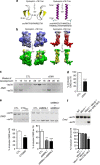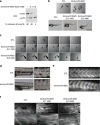Abnormal splicing switch of DMD's penultimate exon compromises muscle fibre maintenance in myotonic dystrophy
- PMID: 26018658
- PMCID: PMC4458869
- DOI: 10.1038/ncomms8205
Abnormal splicing switch of DMD's penultimate exon compromises muscle fibre maintenance in myotonic dystrophy
Abstract
Myotonic Dystrophy type 1 (DM1) is a dominant neuromuscular disease caused by nuclear-retained RNAs containing expanded CUG repeats. These toxic RNAs alter the activities of RNA splicing factors resulting in alternative splicing misregulation and muscular dysfunction. Here we show that the abnormal splicing of DMD exon 78 found in dystrophic muscles of DM1 patients is due to the functional loss of MBNL1 and leads to the re-expression of an embryonic dystrophin in place of the adult isoform. Forced expression of embryonic dystrophin in zebrafish using an exon-skipping approach severely impairs the mobility and muscle architecture. Moreover, reproducing Dmd exon 78 missplicing switch in mice induces muscle fibre remodelling and ultrastructural abnormalities including ringed fibres, sarcoplasmic masses or Z-band disorganization, which are characteristic features of dystrophic DM1 skeletal muscles. Thus, we propose that splicing misregulation of DMD exon 78 compromises muscle fibre maintenance and contributes to the progressive dystrophic process in DM1.
Figures




References
-
- Brook J. D. et al.. Molecular basis of myotonic dystrophy: expansion of a trinucleotide (CTG) repeat at the 3' end of a transcript encoding a protein kinase family member. Cell 69, 385 (1992). - PubMed
-
- Fu Y. H. et al.. An unstable triplet repeat in a gene related to myotonic muscular dystrophy. Science 255, 1256–1258 (1992). - PubMed
-
- Mahadevan M. et al.. Myotonic dystrophy mutation: an unstable CTG repeat in the 3' untranslated region of the gene. Science 255, 1253–1255 (1992). - PubMed
-
- Kanadia R. N. et al.. A muscleblind knockout model for myotonic dystrophy. Science 302, 1978–1980 (2003). - PubMed
-
- Kanadia R. N. et al.. Developmental expression of mouse muscleblind genes Mbnl1, Mbnl2 and Mbnl3. Gene Expr. Patterns 3, 459–462 (2003). - PubMed
Publication types
MeSH terms
Substances
Grants and funding
LinkOut - more resources
Full Text Sources
Other Literature Sources
Medical
Molecular Biology Databases

